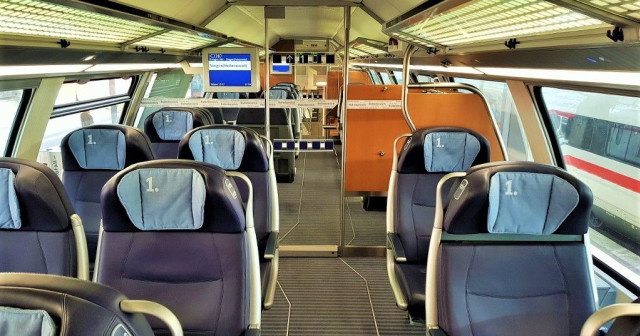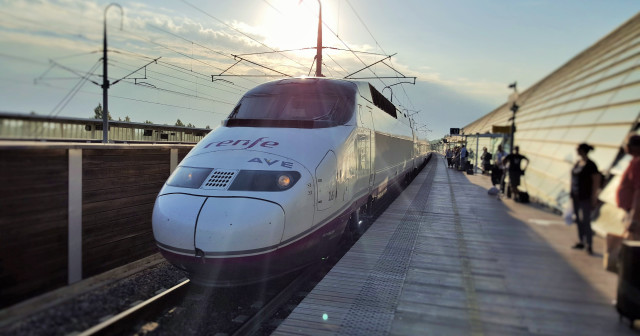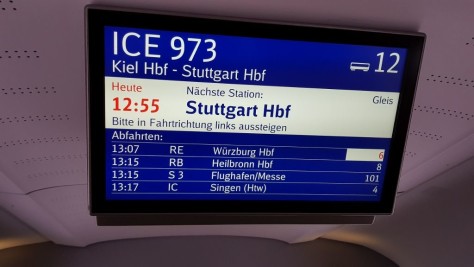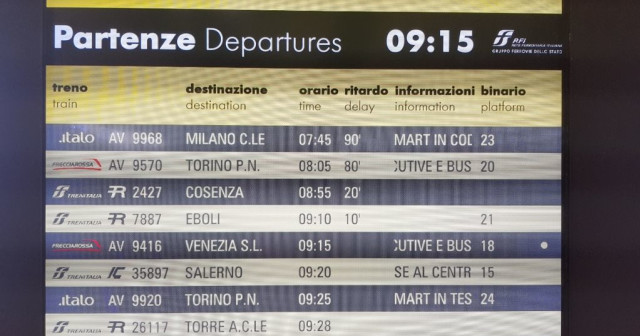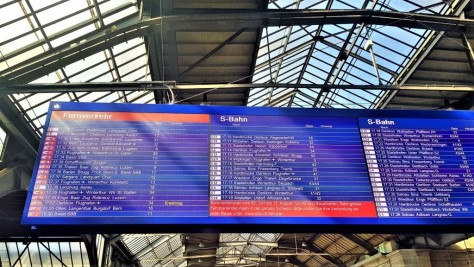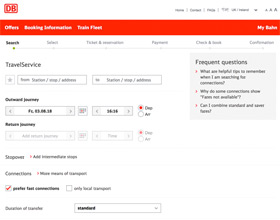Train travel in Europe
How to travel by train in Europe
Want to take a new European train journey and not sure how? This beginner’s guide can help make that idea a reality, as it’s a gateway to a wealth of info compiled over the past four years!
Share
One of the things which inspired the creation of ShowMeTheJourney is the gap between those who say they want to go by train and those that actually go ahead and make a journey.
So this guide will help remove concerns about how to get from A to B by train in the 15 European countries which have the highest number of rail travellers.
It’s packed with links to fairly detailed explanations of those aspects of train travel which can be confusing, such as how to buy train tickets, find trains at stations and discovering if a train can take you where you want to go.
But this beginner’s guide to European train travel will also show you how to make the most of the journey, by using the on-board facilities and seeing the best of the scenery.
The core idea is to show you that taking a new European train journey can be much easier than you think it would be.
Though the many quirks around European train travel have had to be included too and explaining them can require a weight of text, but that knowledge is key to understanding the wonders of European travel.
Smarter and faster trains, easier to use stations, more direct routes and simpler online ticket booking, all contribute to this Golden Age of European Rail Travel, so now you can discover it for yourself.
How easy will your journey be
If you’re considering a rail journey the first thing you need to know is whether you can get there by train.
Because the goal of train travel providers is to make money, direct trains are typically available if you’ll be trying to travel from one city to another that’s less than 150km / 100 miles in distance; and many trains inevitably cover much longer-distances.
Europe’s main railway routes have always been planned so that the dominant cities in a country can be connected as quickly as possible, but this also means that capital cities can be similar to spokes in a wheel, from which railway lines fan out across a nation.
This is the case when travelling to and from London, Paris, Madrid, Prague, Budapest and Stockholm, meaning that rail journeys across country are less frequent but they are possible.
In other countries, cities other than the capital have become the hubs of railway networks, including Frankfurt in Germany; Milan and Bologna in Italy; and Zurich in Switzerland.
Many railways across Europe have also been built with tourists front of mind, or have survived because of the access they provide to dramatic landscapes.
Hence it’s possible to take trains to, from and within beautiful locations such as the Swiss Alps, the Scottish Highlands, The Black Forest, Wales and pretty much anywhere on the Mediterranean Sea’s northern coastline.
You can look for journey guides to taking more than 1000 of most popular rail routes using the search box below.
The guides show whether a journey is direct, requires connections, how frequent the trains depart, how long the journey will take and what to look out for when booking tickets.
They feature easy access to useful info on the stations and trains, plus links to the multiple agents which sell tickets for the journey online; and on the scenic routes there are tips for making the most of the journey.
- Austria by train
- Innsbruck
- Salzburg
- Wien / Vienna
- Belgium by train
- Bruxelles / Brussels
- Czechia by train
- Praha / Prague / Prag
- Denmark by train
- København / Copenhagen
- France by train
- Lille
- Lyon
- Marseille
- Paris
- Germany by train
- Berlin
- Frankfurt (Main)
- Hamburg
- Köln / Cologne / Koeln
- München / Munich
- Great Britain by train
- Edinburgh
- Glasgow
- London
- Manchester
- Hungary by train
- Budapest
- Italy by train
- Bologna
- Firenze / Florence
- Milano / Milan / Mailand
- Roma / Rome
- Torino / Turin
- Venezia / Venice / Venedig
- Verona
- Netherlands by train
- Amsterdam
- Norway by train
- Oslo
- Poland by train
- Warszawa / Warsaw
- Spain by train
- Barcelona
- Madrid
- Sweden by train
- Stockholm
- Switzerland by train
- Basel / Bâle
- Bern
- Genève / Geneva
- Zürich / Zurich
- No Matching Cities
- List is empty.
- No Matching Cities
- List is empty.
Making connections
Taking direct trains isn’t always an option due to geography or quirks of railway history, but this doesn’t have be a barrier to making a rail journey.
The railway networks of Austria, Switzerland and The Netherlands function like giant metro systems, with simple as can be connections between trains.
What can be a tad trickier are the longer journeys by express trains, which can require seemingly random connections.
When buying tickets for such journeys, the ticket agents tend to assume that you’ll want to reach a final destination in the fastest possible time, but that can involve making connections against the clock; and yes this is best avoided.
One of my golden rules is to always allow more than 30 minutes to make a connection between trains, because it typically makes an end-to-end journey less stressful.
More often than not ticket agents don’t sell tickets for journeys which involve a risk to a traveller losing out financially, in the event of missed connections, due to delays to a preceding train.
Though having to visit a travel desk mid-journey to rearrange tickets and reservations on subsequent trains is a scenario best avoided.
So three tips to avoid it:
- On the advance search options on many booking services its possible to set a minimum connecting time between trains, so set it to at least 30 minutes.
- If you’re given a choice of end-to-end journey options with connections, don’t choose the final option of the day, set off earlier and give yourself more contingency time in the event of delays.
- Book separate tickets for each part of a journey and give yourself three hours or more to see something of the city, where you will be making a connection, between trains. Drop your bags in the left-luggage and set off exploring, or have a long lunch in a restaurant in or near the station.
How to travel
Having established that a train can take you to your destination, you can decide how you are going to make the journey, because on most European trains first and second class will be available.
On express trains in first class ,the seats are always larger and the space between them is greater in comparison to second class, so the core idea is that the journey will be more comfortable, the more you pay for your ticket.
Though whether you choose first or second makes little difference to the ticket booking.
Typically the different types of ticket will be available for travel in first or second; and how the tickets can be used is dictated by the type of ticket and not which class you have chosen to travel by,
However, in Germany if you book first class tickets for a journey by an express, IC, or ICE train, you will have a complimentary seat reservation.
If you won’t be travelling long-distance, so will be taking a regional train, the difference between second and first class can seem marginal, but what you are partially paying for by booking first class tickets, is a higher possibility of finding available seats when travelling on trains on which reservations are not available, or are optional.
Travelling in first class is also the only means of accessing these travel benefits; when they are available on a route:

- Travelling in single seat with no other traveller beside you; the seats in the first class areas on most European express trains are arranged 1 + 2 across the aisle.
- Access to passenger lounges at stations; though in some countries including France, these are now only accessible to bookers of the equivalent of Business Class tickets.
- Not having to leave your seat in order to obtain hot food.
The first class travel experience can vary significantly depending on the specific train service that you will be travelling by, with the key difference being the catering service which will or won’t be available to first class passengers at their seats.
It ranges from a complimentary meal, similar to what would be served in a restaurant car on the train, to no at-seat service at all.
Less obvious benefits of travelling first class can include:
- More space in which to store luggage
- Access to enhanced Wi-Fi
- More power sockets, including USB sockets
- An increase likelihood of being sat at a table.
First Class travel on European trains Is First Class worth it on European trains is a commonly asked question. Though due to the varieties of enhanced comfort and on board service, it doesn’t have a definitive answer, but more often than not, it will be a yes.
First Class travel on European trains Is First Class worth it on European trains is a commonly asked question. Though due to the varieties.
European Daytime Trains: A Beginner’s Guide the on board facilities of more than 70 European train services; check the catering, whether you can take bikes and what’s available in 1st class
European Daytime Trains: A Beginner’s Guide the on board facilities of more than 70 European train services; check the catering, whether you can.
A quick guide to train tickets
There are two core paths to take to obtaining tickets for your rail journey:
(1) booking walk-up tickets at the station just before boarding;
(2) booking online before you head to the station.
Travellers can be wary of booking at stations because the ticket counter staff may not speak English, but two tips around this are:
- give the ticket machines a try, those you’ll find at major stations generally have excellent multi-lingual translations.
- look up a journey, using the tips below, and take the info, the departure times and train number to the ticket desk; don’t worry about what a train number is, that’s explained further down the page.
The core reason for making the effort to book online is to save money, because if you want to take an express train service, no matter the distance, it’s more than likely that discounted tickets will be placed on sale; and the further ahead you book, the cheaper they will be.
Train journeys in Belgium and The Netherlands are exceptions.
You can also book these discounted tickets at the Advance travel desks at major stations, but to make the biggest savings you typically have to book weeks ahead.
In contrast tickets for local and regional trains are hardly ever discounted, so usually you won’t lose out if you book them just before hopping on board.
Direct regional trains can travel long-distances such as Roma ↔ Firenze/Florence; Lyon ↔ Marseille and Munche/Munich ↔ Salzburg.
if you will be buying walk up tickets at the station, regional services such as these, are often cheaper than travelling by the express trains.
An Introduction To Buying Tickets for European Train Journeys The key things worth being aware of when buying tickets for European train journeys, including step-by-step guides to booking tickets online.
An Introduction To Buying Tickets for European Train Journeys The key things worth being aware of when buying tickets for European train journeys, including step-.
Checking train times
So the suggestion above was to buy tickets for journeys by local and regional trains at the station, so this nugget of advice will seem a tad bizarre.
Because before heading to the station it’s a good idea to check the times of the departures to your destination, more often than not, this is most easily done by looking up a journey on a ticket booking service.
Many of them now have a check train-times functionality.
Most European countries offer train journey planning and timetables apps and online services; you’ll find links to them on the country guides.
Online ‘departure boards’ are also available for most main stations and if a station has one, you’ll find a link to it on the station guides.
A frequent longer-distance express or regional rail service in Europe would comprise a train every hour, and a frequent local service would be a train every 30-60 minutes.
This level of frequency is typical across Belgium, Switzerland and The Netherlands, and is also found away from the rural areas of Austria, Denmark, Germany, Great Britain, Hungary and Italy.
Though countries in which the timetables are less regular include France, Norway, Poland, Spain and Sweden.
Why it matters in which country you’ll be travelling
One of the odder aspects of European train travel is the variations between how rail journeys can be taken in each country.
All European countries either have a dominant government funded national rail operator, or a state managed organisation which oversees its railways, and they set the ‘rules’ around travel.
So each country has it own policy around multiple aspects of travelling by train, which include, but are not limited to:
-
tickets are placed on sale.
- The T&Cs around the refund and exchange of train tickets.
- The seat reservation policy on express trains.
- What extras you will and won’t receive on board if you book First Class tickets
- The T&Cs for child tickets.
- How to travel on trains with a non-folding bicycle.
- How to travel on trains with a dog.
- The T&Cs for using rail passes such as Eurail and InterRail.
- Whether railcards which save money on tickets will be available.
Of course if you’re only making some journeys by train in Italy you won’t need to know the ‘rules’ around taking bikes on trains in France. However, if you’re a regular traveller by train in your home European country, it’s easy to assume that what you know about buying train tickets etc will also apply in another country, but it won’t.
Hence the guides to travelling by trains in these 15 countries on the buttons below, will be worth the 10 mins of your time that it will take to read them; and more of them will be added soon.
- Austria by train
- Innsbruck
- Salzburg
- Wien / Vienna
- Belgium by train
- Bruxelles / Brussels
- Czechia by train
- Praha / Prague / Prag
- Denmark by train
- København / Copenhagen
- France by train
- Lille
- Lyon
- Marseille
- Paris
- Germany by train
- Berlin
- Frankfurt (Main)
- Hamburg
- Köln / Cologne / Koeln
- München / Munich
- Great Britain by train
- Edinburgh
- Glasgow
- London
- Manchester
- Hungary by train
- Budapest
- Italy by train
- Bologna
- Firenze / Florence
- Milano / Milan / Mailand
- Roma / Rome
- Torino / Turin
- Venezia / Venice / Venedig
- Verona
- Netherlands by train
- Amsterdam
- Norway by train
- Oslo
- Poland by train
- Warszawa / Warsaw
- Spain by train
- Barcelona
- Madrid
- Sweden by train
- Stockholm
- Switzerland by train
- Basel / Bâle
- Bern
- Genève / Geneva
- Zürich / Zurich
- No Matching Cities
- List is empty.
- No Matching Cities
- List is empty.
Know your stations
This may be No.1 on the most potentially confusing aspects of European train travel, as many major cities have more than one station used by long-distance trains.
This matters both when booking tickets; travelling to one station can be cheaper than another; and when you’re on the train you need to know where to leave it.
Hence the journey guides show how to take trains from and to the main stations in each city and they also point out the alternative station options.
It can be a good idea to check the locations of the start and finish points of your end-to-end journey on Google Maps and seeing either, which are the nearest main stations, or which have the easiest public transport connections.
Larger cities including Budapest, Paris, London and Madrid have no main central station, but instead have multiple stations on the edge of their central area, serving trains which head off in different directions.
The use of word resembling ‘Central’ in a station name means that the station will indeed be the main city centre station, but not all stations follow this pattern.
In Austria and Germany the main city centre stations are known as hauptbahnhofs, which is often shortened to ‘hbf’; in Czechia ‘hln’ is used and in Poland the main stations are ‘glowny.
Other main city stations can be named after a local landmark, a local area, or named in honor of an individual, hence these being some of the less obvious names of main city centre stations:
- Barcelona Sants
- Birmingham New Street
- Edinburgh Waverley
- Firenze Santa Maria Novella (Florence)
- Marseille St Charles
- Roma Termini (Rome)
- Venezia Santa Lucia (Venice)
- Verona Porta Nuova
The language of train travel
The info is showing the next station call and the connections which will be available
Taking a new train journey requires the taking on of information, buying the appropriate ticket, finding the train at a station and working out when to leave it etc.
Therefore many would be travellers have concerns that they will be able to understand this info in a foreign land.
However, most of the info that rail traveller’s need is presented visually on the departure screens at stations and increasingly on displays within the train.
Also many announcements at stations and on board trains are in both the native language and English, though France is an exception to this.
But train travel itself has a unique vocabulary and it inevitably gets used all over ShowMeTheJourney, including this guide.
So if you’re confused by what is meant by reservations, train numbers, rail passes etc, check out the guide below.
The Language of Train Travel This guide to the vocabulary of European train travel helps explain the terms and phrases you may see at stations, on timetables and on websites
The Language of Train Travel This guide to the vocabulary of European train travel helps explain the terms and phrases you may se.
Finding your train:
Like many European station departure boards, this one at Zurich’s main station only shows the main calling points of each train
The major stations of Europe can be awe-inspiring, but they can also be tricky to navigate, partially because they weren’t designed with once in a lifetime travellers front of mind, hence many of them feature multiple entrances and short-cuts, to make life easy for their daily users.
Some of them also have multiple parts, used by different train services, and some of these different areas of a station can be some distance from the main entrance.
Other stations are akin to layers of cake, with some of the trains leaving from parts of the station above ground, with others using subterranean parts of the station, even though they are not metros.
These multi-dimensional stations, of both types described above, include: Antwerpen Centraal, Berlin Hbf, Bern, Bologna Centrale, Bruxelles-Midi; London St Pancras International, Madrid Atocha, Manchester Piccadilly, Munchen Hbf, Paris Gare De Lyon, Paris Montparnasse, Roma Termini, Wien Hbf and Zurich HB.
So if you already have a ticket it can be a good idea to be at a major station for the first time a minimum of 15 mins before your train departs
If you will joining a train at city station where it’s commencing a journey and don’t have a reservation, add on another 15mins, so that you can be among the first to board when your train’s departure details are confirmed.
If you’ll be buying a ticket at station allow 30 mins to make a purchase to allow for queues at both ticket counters and ticket machines.
Add on another 20 mins to all of the above timings, if you’ll want to buy a coffee etc before heading to the train, this last minute food/drink purchasing can be more complicated that you might assume.
If you will be taking a Eurostar, or a high-speed train in Spain or a Thalys train service, also factor in the check-in times / security procedures.
Heading to the train
You will be likely relying on the visual info at the station to find the train you’ll be taking, because these days the details of departures are rarely announced.
So you’ll need to use two types of visual info, one of which will tell you the platform/track etc you will need to head to; and the other will tell you how to make your way to it.
Most of Europe’s large multi-level stations have elevators which give access to the trains if you have heavy luggage etc, but they can be out of sight, away from the most obvious routes to the departures.
So if you’ll want to use them don’t assume that they don’t exist because you can’t see them, look out for them on the station signage, or ask station staff.

Precisely how you find out which platform/track you need head to varies between counties, hence the guides to using stations below, plus the info you’ll find on the country guides, but the three key pieces of info, which will help identify the train you need to take, are:
(1) It’s departure time – if you will taking a local train so the time won’t be on the ticket, ask at the ticket counter what time it will be leaving.
(2) The final destination of the train – it will be either written in the language at the destination, or the local language of where you are; so look that info up before you head to the station, it can be super useful to know that Anvers = Antwerp; Firenze = Florence; Wien = Vienna etc.
This can matter because most of the main departure boards at European stations won’t show every station that the trains will be calling at; though Great Britain is an exception to this.
It’s why the final destination of the train is always included on the journey guides.
(3) Using train numbers – In Austria, France, Czechia, Germany, Italy, Poland, Spain and Sweden, the easiest method of finding your train on the departure board, is to match the train number on your ticket, to the corresponding numbers on the departure screens.
On this Italian departure board:
Train no. 2280 is leaving from platform 3 and Train no. 2129 is leaving from platform 4.
Train numbers for international trains can also be shown in countries where numbers aren’t used for the domestic services.
The key piece of information you’ll need to know is which platform / track your train will be leaving from.
Many European departure boards have multi-lingual headers which will show where to look for these platform/track details
Also don’t be surprised if when you first look at a board you see a blank space where the info should be, becasue it will suddenly appear as soon as it is confirmed.
Even without a translation it’s normally fairly easy to work out where to look, because its the column with the least info in it.
Though at stations, systems of letters can be used for each platform/track instead of numbers
Plus at most Dutch stations and some British stations, including Birmingham New St, Edinburgh Waverley and Leeds, you will see both a number + a letter; because the platforms are split into different sections indicated by the letters, and trains can depart from these specific sections.
Also in eastern Europe including in Poland and Croatia you may see two numbers, one of which is for the platform and the other is for the track, because the platform can be split into the equivalent of the quarters.
There’s no getting away from how confusing all of the above can be, but most major European stations have information desks at which you can check everything you need to know about how to find your train.
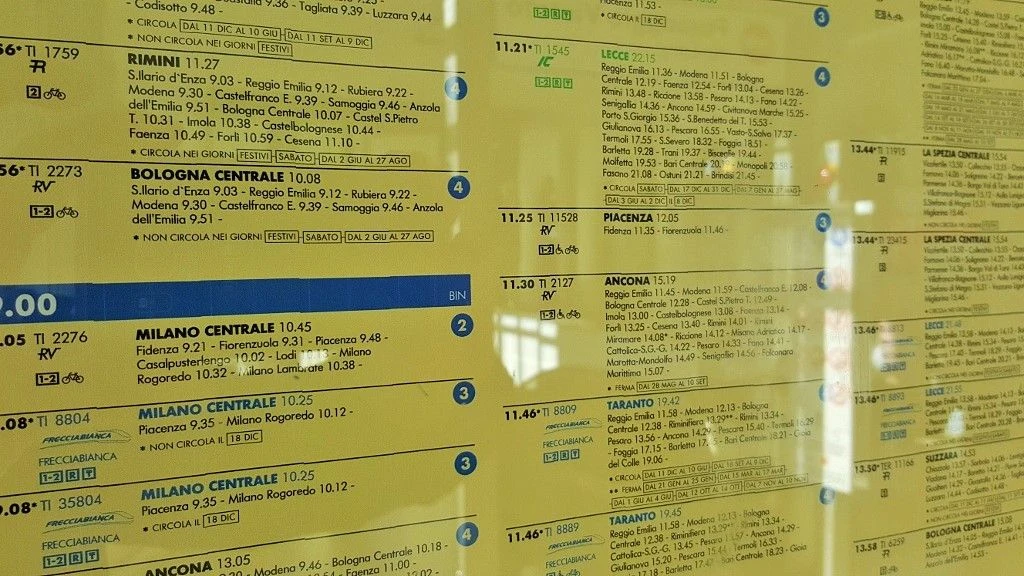
Though once you have ticket there is often an ol-skool method of working out where your train will/should be leaving from.
At stations in Austria, Belgium, Germany, Italy, Poland, Spain and Switzerland, there will be departure posters listing every train and they have the platform/track numbers on them.
Though if the info on the screens is different, follow that instead.
If you will be joining a train at an intermediate station, there will be other departure screens on the platform which show the details of the next train to be leaving from it.
So you can confirm you’re at the right place, but look twice because your train may not be the next to leave.
These screens can also show info that wasn’t on the main departure board, including all of the calling points and where to wait for easy boarding into 1st class, the on-board restaurant, or the bike spaces.
If you will be changing trains look out for any departure summary screens, when you step off the train.
Train travel
in Australasia
There’s no need to fly within Europe. It’s surprisingly easy, quick and comfortable to travel by train from London to almost anywhere: Spain, Italy, Switzerland, Greece, Prague, Helsinki, wherever. The difficult bit is finding out how to do it and where to buy tickets. That’s where Seat 61 comes in.
This website explains the best routes, train times & fares from London to major destinations all over Europe, and between the main cities within Europe.
It explains the best way to buy tickets for your specific journeys, whether you live in the UK, mainland Europe, the USA, Australia, wherever.
Train times & tickets
If your journey starts in the UK, select your destination country in the upper drop-down box to see the best routes, train times, fares & how to buy tickets.
If your journey starts in another European country, select the city where your journey starts in the lower drop-down box – if it isn’t listed, select one nearest to it in the same country.
Return to this page for general information & advice about European train travel.
Planning your trip
How to buy tickets
Luggage, bikes, dogs & cars
About specific trains & routes
If the route you want isn’t listed
here, select the starting city in
Station guides
How to check train times.
Click for an online
European train timetable.
If you only remember one European train travel resource – apart from seat 61 of course – make it www.bahn.de/en. This has an excellent online timetable for the whole of Europe, probably the most useful European train travel resource on the net. Ask it for Palermo to Helsinki or Lisbon to Moscow and you’ll see what I mean. These tips may help:
Go to www.bahn.de/en: This takes you to the advanced journey planner in English.
www.bahn.de without the /en takes you to their German-language home page, change Deutsch to English top right then click the Further options button for the advanced journey planner.
Like I said, it’s easier to use and remember Bahn.de/en!
Place names: It recognises English-language place names & prompts with station or city names.
If you don’t know which station to select, select the plain city name, often in capitals, for example PARIS or BERLIN. The system will then work out which is the relevant station for your journey.
If it only offers specific stations, try to select the main station in that city, which may be shown as main station or (in Italy) Centrale, in the Netherlands as Centraal, in Germany or Austria as Hauptbahnhof, Hbf or HB (= main station in German), Hlavni in Czech or Glowny (Gl.) in Polish.
In Brussels, Brussels South Station is the main station, also known as Brussels Midi or Brussel Zuid. In Barcelona, select Barcelona Sants. In Verona, select Verona Porta Nuova. In Turin, the main terminus station is Torino Porta Nuova, but the TGV trains to/from Paris use Torino Porta Susa, which many trains leaving from Porta Nuova heading for Venice or Rome also call at. In Venice, Venice Santa Lucia is on the Grand Canal in central Venice, Venice Mestre is on the mainland. In Lisbon, select Lisbon Santa Apolonia.
When the search results appear, click on show details to see a detailed breakdown of the journey.
To see an end-to-end timetable for a train with all calling points, click on show details then click on the train number. It’ll show the complete origin-to-destination timetable with days of operation & all calling points, and whether it has a restaurant or bar.
It only holds data for the main rail operators plus some smaller operators, not for all trains everywhere. Notably it does not cover:
– Some private open-access operators such as Italo in Italy, Ouigo in France.
– The Circumvesuviana Railway, Naples-Herculaneum-Pompeii-Sorrento.
– Euskotren in Spain, operating narrow gauge local trains between Hendaye, San Sebastian & Bilbao.
– FEVE in Spain, who run narrow gauge local trains along the north coastal towns.
– Spanish suburban routes including Latour de Carol to Barcelona & Cerb�re to Barcelona.
– It doesn’t always hold full or accurate data for the Balkans or Greek domestic trains.
For British train times it’s better to use www.nationalrail.co.uk as this will show any engineering work alterations.
Timetable changes in June & December: It usually holds data only until the next Europe-wide timetable change, which happens twice a year at midnight on the 2nd Saturday in June & December. So don’t be surprised if it shows no trains running in late December if you ask it in August, that’s beyond the December timetable change. Data for dates after the December timetable change usually starts to come online by mid-October and isn’t 100% reliable until early December. Also note that data for French, Italian & Spanish trains will only be held for the next few months, not for the whole timetable period.
This system is very good, but some railways (typically the Spanish, Hungarians, Polish & Balkan railways) can be late in supplying data, and data can be unreliable in some parts of the Balkans, for example. If you get strange results you can try the railway operator’s own website instead, for example www.renfe.com for Spain or www.ose.gr for Greece. There’s a complete list of rail websites on the useful links page.
You can adjust transfer times, add a via station or add a stopover: By default it allows the minimum time to change trains, whether changing into a local train that runs every 30 minutes or into a sleeper train which you can’t afford to miss. It won’t suggest impossible connections, it always allows enough time to walk from one train to the other if the first train is on time, but it doesn’t take into account the possibility of the first train running 20 minutes late. It’s often a good policy to allow more time for transfers, so click Stopover and change Duration of transfer standard to another value. On a through ticket you’re legally entitled to later onward travel if a delay means a missed connection (more info on that here), but with separate non-refundable train-specific tickets the risk is yours so you should allow more than the minimum, see more about how long to allow for connections here. You can also set one or two via stations if you want it to find journeys via a particular route, and by adding a duration in the hh:mm box you can specify stopovers at these stations.
Fares & tickets: www.bahn.de will show train times for virtually any journey in Europe, but will only show fares and sell tickets for journeys to, from or within Germany, plus a few cross-Germany routes such as Belgium/Netherlands to Switzerland, Denmark, Sweden, Poland, Czech Republic. To check fares for other journeys, see the How to buy European train tickets page.
 |
Smartphone apps.
DB Navigator is a free online train timetable app for all of Europe, the app version of the German Railways all-Europe online timetable at bahn.de. It provided a journey planner, train details, and calling points, though it needs a WiFi or mobile data connection. To download, go to www.bahn.com/en and look for the Apple Store & Google Play download links at the bottom of the page.
Railplanner is a free offline train timetable app that you can download onto your smartphone to check train times & train calling points on the move without the need to be on WiFi or to use mobile data. It’s blisteringly quick and covers almost all the train covered by the DB Navigator app. The whole European timetable sits on your smartphone, with updates automatically downloaded every month. It’s created with Eurail and Interrail passholders in mind, but is useful for anyone. Download for iPhone or Android at www.eurail.com/en/plan-your-trip/rail-planner-app – please let me know if the link stops working!
Station arrivals & departures.
Click here & enter a station to check scheduled train departures or arrivals at almost any station across Europe using www.bahn.de/ris. This is an online equivalent of the printed departure posters displayed at stations. It shows real-time information for stations in Germany if you pick today’s date, but for ‘real time’ information in other countries, see the real-time section below.
The European Rail Timetable.
The world-famous European Rail Timetable is the train traveller’s bible, with route maps and up-to-date timetables for trains, buses and ferries for all European countries, plus trains in Asian Turkey and Russia including the Trans-Siberian railway, ferries to North Africa & the Mediterranean islands.
Published since 1873, it had just celebrated 140 years of publication when Thomas Cook pulled the plug on their entire publishing department, and the August 2013 edition was the last to be published by Thomas Cook. The good news is that the dedicated ex-Thomas Cook team set up a private venture and a reborn European Rail Timetable continues to be published. Remarkably, the timetable has now survived its parent company, as Thomas Cook collapsed in 2019. What does it contain?
Buy online at www.europeanrailtimetable.eu for around �16.99 with shipping worldwide.
If you live in the UK you can also buy from www.amazon.co.uk, it’s eligible for Amazon Prime next-day delivery.
How to check fares & buy tickets.
This section has turned into a bit of an essay. If you just want to know how to buy tickets, skip this section, go to the How to buy tickets page, select a specific journey and I’ll tell you how to book it. If you’re interested in how European train booking works (or doesn’t), read on.
Reality check: No single website sells tickets for all trains in all countries.
Although you can look up train times almost anywhere in Europe using www.bahn.de/en, there isn’t a single website that can show fares & sell tickets for every European train in every country.
So you can’t go to europeanrailways.com (there’s no such site) and buy a Stockholm to Alicante ticket (there’s no such ticket). It’s perfectly possible to travel by train from Stockholm to Alicante, but we’re talking 6 trains run by 5 different operators ticketed with at least 4 separate tickets. Ah, I see from the look on your face that realisation is beginning to dawn.
Each country has its own national operator with its own website.
Each national train operator has its own website and its own ticketing system. Then there are various private operators, either genuinely independent such as Italo, Regiojet or Leo Express, or pseudo-independent such as Thalys or TGV-Lyria created by the relevant national rail operator(s) to run specific international routes.
In fact, Europe has over 50 different rail operator websites selling train tickets for their own trains, even before considering third-party ticket resellers. You need to use the right website for the right journey. So which is the relevant operator for your journey?
If you go to the How to buy tickets page, select your starting city, and on the next page select your destination, you’ll find my advice on how to book that specific route.
However, as a rule of thumb, if there’s a named operator such as Eurostar or Thalys or Regiojet you’d go to that operator’s website, in this case Eurostar.com or Thalys.com or Regiojet.com. If it’s a normal international train jointly run by the relevant national rail operators, your starting assumption should be to use the national rail operator website for the country where your journey starts, then check the one where it ends.
The pseudo-independent operators can also be booked at the owning national operator sites.
Eurostar is 55% owned by French Railways (SNCF), and Eurostar tickets can also be bought at SNCF’s website www.sncf-connect.com. Thalys is owned by French, Belgian & Dutch national railways, and can also be booked at www.sncf-connect.com or the Belgian Railways site b-europe.com or the Dutch Railways site nsinternational.com. TGV-Lyria is owned by SNCF & SBB (Swiss Railways) and can also be booked at www.sncf-connect.com or www.sbb.ch. The national operator sites can of course book other trains in their respective countries too, in connection with Eurostar or Thalys or TGV-Lyria. So London to Avignon by Eurostar & onwards French train can be booked as one transaction at French Railways www.sncf-connect.com, for example. It can be useful to know that!
International trains can usually be booked at the national operator website at either end.
For international journeys, your starting assumption is to book them at the national rail operator website for the country where the journey starts. But if a train can be e-ticketed, you can also book using the destination country’s national train operator website.
For example, Berlin-Prague trains are run jointly by German & Czech national railways, and can be booked at either German Railways www.bahn.de or Czech Railways www.cd.cz with print-your-own tickets.
Now it gets interesting, as this is one of the routes where each partner operator manages advance-purchase price levels independently. So the price at bahn.de might be �39 (with cheaper �19 & �29 tickets sold out), whilst �19 tickets remain available for the same train at cd.cz. It pays to check both!
In fact, even the fixed-price full-flex fare can differ between partner operators. As I write this, Austrian Railways (�BB) charge �64 for a full-flex on-the-day ticket from Vienna to Prague, but even if you were in the �BB ticket office at Vienna Hbf, it’d be cheaper to whip out your smartphone and buy exactly the same ticket for the same trains from Czech Railways for �42.
But a word of warning: Check ticket delivery carefully if buying from the operator at the destination end. For example, Austrian Railways oebb.at issues print-your-own tickets for Vienna-Venice trains so can be used for either direction. Trenitalia.com can also book these Vienna-Venice trains, but you must collect a hard-copy ticket from a Trenitalia ticket machine or ticket office in Italy – not much help if you’re starting in Vienna!
There are exceptions to this rule, of course. The Paris-Milan Frecciarossas enter France on an open-access commercial basis, so can only be booked at Trenitalia.com, not SNCF-connect.com. Whilst the competing Paris-Milan TGVs enter Italy on an open-access commercial basis and can only be booked at SNCF-connect.com, not Trenitalia.com.
Some trains aren’t bookable online at all.
Another reality check: Slovenian, Croatian, Bulgarian & Turkish railways don’t sell international tickets online, for example. Trains between Slovenia or Croatia & Germany can be booked online in either direction at German Railways www.bahn.de. Trains between Slovenia or Croatia & Austria can be booked online in either direction at Austrian Railways www.oebb.at. But the only way to buy tickets from Ljubljana to Zagreb or Zagreb to Belgrade or Sofia to Istanbul, is at the station.
Longer journeys often need to be broken down into stages.
Many international journeys involve a change of train, often this means a change of operator. Operator websites may not be able to sell tickets for such journeys. Nice to Milan can’t be booked at the French Railways website www.sncf-connect.com, because SNCF can’t access prices or tickets for the Trenitalia train between Ventimiglia & Milan (Ventimiglia is the border station where you change trains). And the Trenitalia website can’t book you from Nice to Milan either, because it can’t access prices or tickets for the SNCF train between Nice & Ventimiglia. You need to book Nice-Ventimiglia at www.sncf-connect.com and Ventimiglia-Milan at Trenitalia.com. Two tickets, two bookings, on two different websites, such is the reality of Europe’s rail network in the 21st century. But there are two specialist retailer sites that resolve this.
Two ticket retailer websites deserve a special mention, www.raileurope.com & www.thetrainline.com. These connect to multiple operators, allowing tickets for trains across much of western Europe to be booked in one place.
They have their own journey planning logic, so (for example) they can work out a suitable journey from Nice to Milan using an SNCF train from Nice to Ventimiglia and a Trenitalia train from Ventimiglia to Milan, they then source the Nice-Ventimiglia ticket from SNCF and the Ventimiglia-Milan ticket from Trenitalia, and add them together to provide you with a Nice-Milan journey as one seamless transaction.
I often recommend www.raileurope.com or www.thetrainline.com as they allow you to book tickets together in one place for journeys that would otherwise require multiple bookings on different websites. They are designed for international users, so happily accept overseas payment cards (some national train operator sites struggle) and are written in plain English (some national rail operator sites slip back into local language or use poor English translations). The downside is that they charge a small booking fee, but it’s often worth paying that.
Raileurope.com or www.thetrainline.com currently connect to the following national railways: Great Britain (National Rail), France (SNCF), Spain (Renfe), Italy (Trenitalia), Germany (Deutsche Bahn), Austria (�BB). They also both connect to private operator Italo. www.thetrainline.com also connects to Swiss Railways (SBB), the Benelux ticketing system (SNCB, NS & CFL) and private operators Regiojet & Westbahn.
Raileurope.com or www.thetrainline.com come as close as you’ll get to a pan-European train booking site, but even they don’t yet connect to the Portuguese, Czech, Slovakian, Slovenian, Croatian, Hungarian, Danish, Swedish, Norwegian, Finnish, Bulgarian, Turkish, Greek, Romanian, or Polish Railways ticketing systems. So for a �15 Lisbon-Porto ticket you still need to go to Portuguese Railways www.cp.pt and the only place you’ll find a �21 Prague-Budapest ticket is Czech Railways www.cd.cz. You get the picture?
Incidentally, you might also come across Omio.com. Omio has similar connectivity, but at the time I write this it doesn’t have any journey planning logic. So although it can sell you a Nice-Ventimiglia ticket using its connection to SNCF if you ask it for Nice to Ventimiglia, and it can sell a Ventimiglia-Milan ticket using its connection to Trenitalia if you ask it for Ventimiglia to Milan, if you ask it for Nice to Milan it will say there are no trains (and will suggest a flight) because it lacks the capability to plan the journey itself and combine multiple tickets. It also says there are no trains for journeys where it lacks the necessary connectivity. For example, Omio says there are no trains from Budapest to Zagreb and suggests a bus, but you can easily buy a train ticket from �19 from Hungarian Railways at www.mavcsoport.hu. So it’s important to understand a site’s limitations. Omio does have some extra connectivity, for example it connects to Swedish Railways sj.se so can be useful to book Swedish trains if sj.se rejects your credit card, and to Portuguese Railways cp.pt which no other site does.
So which website should you use to buy tickets?
Don’t worry! On seat61.com I’ll tell you the right website(s) to use for any given European journey (well, almost). Go to the How to buy European tickets page and select your starting city. On the next page, select your destination city. I’ll then explain the different ways you can make that specific journey and which website(s) to use to buy tickets.
To check fares & buy tickets within one country.
You can check fares & (usually) buy tickets for domestic journeys at each country’s national rail website, see the links page for a complete list.
Should you buy European train tickets in advance: Yes, and here’s how to save
About a million years ago, buying train tickets for your European trip was very easy and straightforward because they all had fixed prices that were reasonable so you could buy your ticket just before the train departed. Then in the early 2000s, that all changed as countries started introducing “dynamic pricing” similar to airlines and suddenly tickets generally started out cheap and went up in price as the departure date drew near.
Now as of 2022, nearly all international train tickets and most domestic European train tickets are sold this way and buying tickets on departure day is usually insanely expensive. Below we will go over what you need to know to save the most on buying train tickets for your Europe trip, and where to buy them as well. One very nice thing is that you can usually download them instantly these days and not have to pay a delivery charge, but there’s more to the story below.
This article was updated in August, 2022.
European train fares are very cheap early, and expensive on travel day
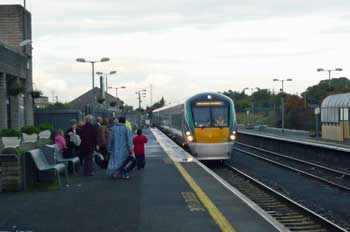
Britain has used a dynamic pricing system on its train lines ever since they privatized them, and the Eurostar from London to Paris or Brussels has long done the same. As of 2022 it seems that every country in Europe has train fares that keep getting more expensive as the travel day nears.
Most suburban/commuter trains continue to have fixed fares that are always pretty reasonable, but on the long distance trains between major cities, you now have to buy early.
Here’s a typical example of how European train fares now work:
Berlin to Munich
- Duration: 3 hours 55 minutes
- Bought today: €142
- Bought one-week early: €126
- Bought one-month early: €54
- Bought three months early: €18
International train fares within Europe all seem to have this dynamic pricing where the fare goes up as the date approaches and more tickets are sold. However, some countries including Switzerland and the Scandinavian countries have fixed domestic fares that can be reasonable if bought on travel day. However, they also have “super saver” fares on some routes where they offer very cheap tickets if you buy far enough in advance.
When to buy European train tickets to get the best fare
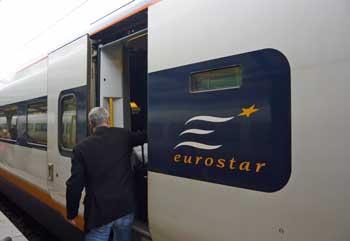
The short answer to the question just above is, “as early as possible.” But that’s easier said than done. For one thing, very few of us are willing to lock in a specific non-refundable train ticket close to 6 months in advance. Most people who are putting together their European itinerary tend to only start the detailed planning a few months in advance at most.
The good news is that you can generally get a decent discount on the full fare if you buy at least a month in advance. And booking a week in advance is almost always cheaper than booking on travel day. You can buy most European train tickets online from anywhere, so it all comes down to how early you are able to commit to a non-refundable ticket in order to save money.
Bottom line: One month in advance will usually get a good fare
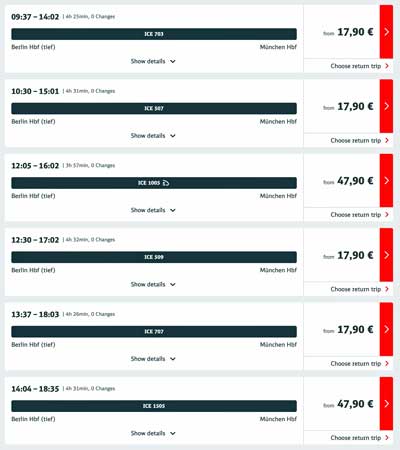
You’ll also usually notice advance fares can be drastically different from one departure to another the longer in advance you look. For example, to the right you’ll see all of the 9 AM to 3 PM departures from Berlin to Munich on a day a little over three months from now. Of the six departures, the two fastest ones (just under 4 hours) are currently priced at €47.90 in 2nd class, while the four slightly slower (around 4.5 hours) departures are still priced at €17.90.
This sort of things is very common as each departure only has a certain number of ultra-cheap tickets on offer and then the price jumps up quite a bit. On this day the two faster trains are sold out of the ultra-cheap tickets, while they are still available for the slightly slower trains. It’s easy to save quite a bit of money when you see situations like this far enough in advance.
Is a Eurail Pass a better option now?
About 10 years ago, these same European rail companies (mostly run by the government of each country) started requiring a seat reservation when using a Eurail Pass on the popular city-to-city train routes. This means that instead of just hopping on any train about to leave the station, pass holders now had to pay about €5 to €10 for a seat reservation if a seat was even available. Suddenly, a Eurail Pass was less fun, or at least less spontaneous than before.
But the reason they started charging for these seat reservations is so they could also adjust the price of the seats and know how many are available. The net result is that paying as you go while trying to decide on trains at the last minute is now insanely expensive. A Eurail Pass will rarely seem “cheap” but it does provide you with much more flexibility and freedom at a reasonable price compared to paying as you go.
Your two cheap options: Buy at least a month early, or get a rail pass
Obviously it depends on exactly where in Europe you intend on taking the train, but for most people there are only two cheap options, each with its own advantages.
Option 1: Buy at least one month early
If you are willing and able to lock in all your rail travel at least a month early, you can still travel around the continent at a reasonable price. Waiting until just a day or two before you want to go can lead to astonishing prices in some cases.
Option 2: Buy a rail pass and travel as you please
Again, a Eurail Pass usually doesn’t look cheap at first glance. You’ll often end up paying around US$60 per ride in addition to about US$7 for a seat reservation. But only rides of 3 hours or less will cost that little on travel day, and they can be as high as US$200 or even more in some countries. A US$67 ride on a rail pass becomes a pretty good deal in comparison.
The 2022 Eurail Passes seem to be quite a bit lower than they had been in 2020, which is probably due to lower ridership during the pandemic. Hopefully these same prices hold up in 2023 because they can be much cheaper than even buying tickets in advance at these prices.
Where to buy advanced European train tickets
There are two basic options when it comes to purchasing advanced train tickets for European trains:
- Rail ticket sites that make it easy and charge extra for it
- Official rail company sites for each country
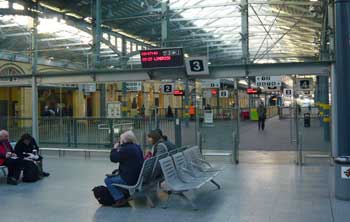
One complication with buying European train tickets online is that some countries have very confusing websites and generally make it difficult for tourists. They offer the best fares though, so for most of it it’s worth a try to see if we can pull it off on our own.
The easiest website to use is raileurope.com, which represents a company that has been in business for many decades and is primarily owned by the France and Switzerland rail companies. They usually charge about 20% more than the country sites, and sometimes it can be higher. But they are also easy to use now in 2022 you buy download tickets instantly for no delivery charge. This used to be a headache but now it couldn’t be easier.
>>>Check raileurope.com for train fares
Using the official country websites for advanced tickets
As mentioned, it’s worth trying the official rail websites to save money. Most of them can be switched to the English language for the whole transaction, although some of them turn back into their native language for the last few steps, which can be aggravating and confusing. You’ll usually be able to have the tickets shipped to your home for an extra fee, and some of them also offer printable e-tickets.
If you are going between countries you can buy the ticket from the rail company of either country, and they should be the same price. The German rail site also sells tickets on some trips that don’t involve Germany, and they are usually the best for checking fares and schedules for anywhere in Europe.
How early do European train tickets go on sale?
The last piece of the puzzle, which makes things even a bit more confusing, is that each country starts selling its train tickets a different amount of time in advance. It can be as little as 1 month ahead of time in Switzerland or Belgium, up to 6 months ahead of time in some other countries.
Source https://showmethejourney.com/travel-info-and-tips/how-to-travel-by-train-in-europe/
Source https://www.seat61.com/european-train-travel.htm
Source https://www.priceoftravel.com/buy-european-train-tickets-in-advance
